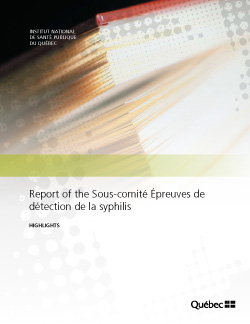Report of the Subcommittee Épreuves de détection de la syphilis: Highlights
Since 2000, the resurgence of syphilis in Québec has led to increased screening and resulted in a greater number of reported cases, particularly in the Montréal area. To meet the growing demand for laboratory testing, some medical diagnostic laboratories have introduced an enzyme immunoassay (EIA) test into their syphilis detection algorithm. This situation raised concerns among general practitioners, microbiologists and infectious disease specialists with regards to the interpretation of screening results and the diagnosis and confirmation of syphilis infections.
In response to these concerns, the Comité sur les infections transmissibles sexuellement et par le sang (CITSS) of the Institut national de santé publique du Québec (INSPQ) established the Sous-comité Épreuves de détection de la syphilis whose mandate was to make recommendations for optimizing syphilis diagnosis in Québec.
To fulfill its mandate, the subcommittee:
- conducted a literature review on syphilis detection tests;
- compiled an inventory of syphilis detection tests used by medical diagnostic laboratories in Québec;
- reviewed serodiagnostic algorithms for syphilis detection used in other Canadian provinces and in other countries;
- reviewed the data analysis from a 2008 validation study conducted by the Laboratoire de santé publique du Québec (LSPQ) on the use of INNO-LIA as a confirmatory test and performed a retrospective analysis of screening and confirmatory test results for 2,132 serum samples analyzed by the LSPQ between January and December 2007.
Based on the aforementioned, the subcommittee proposed and validated two syphilis detection algorithms. An accompanying interpretation of results chart was also developed.
Le rapport intégral est également disponible : Rapport du sous-comité Épreuves de détection de la syphilis.


